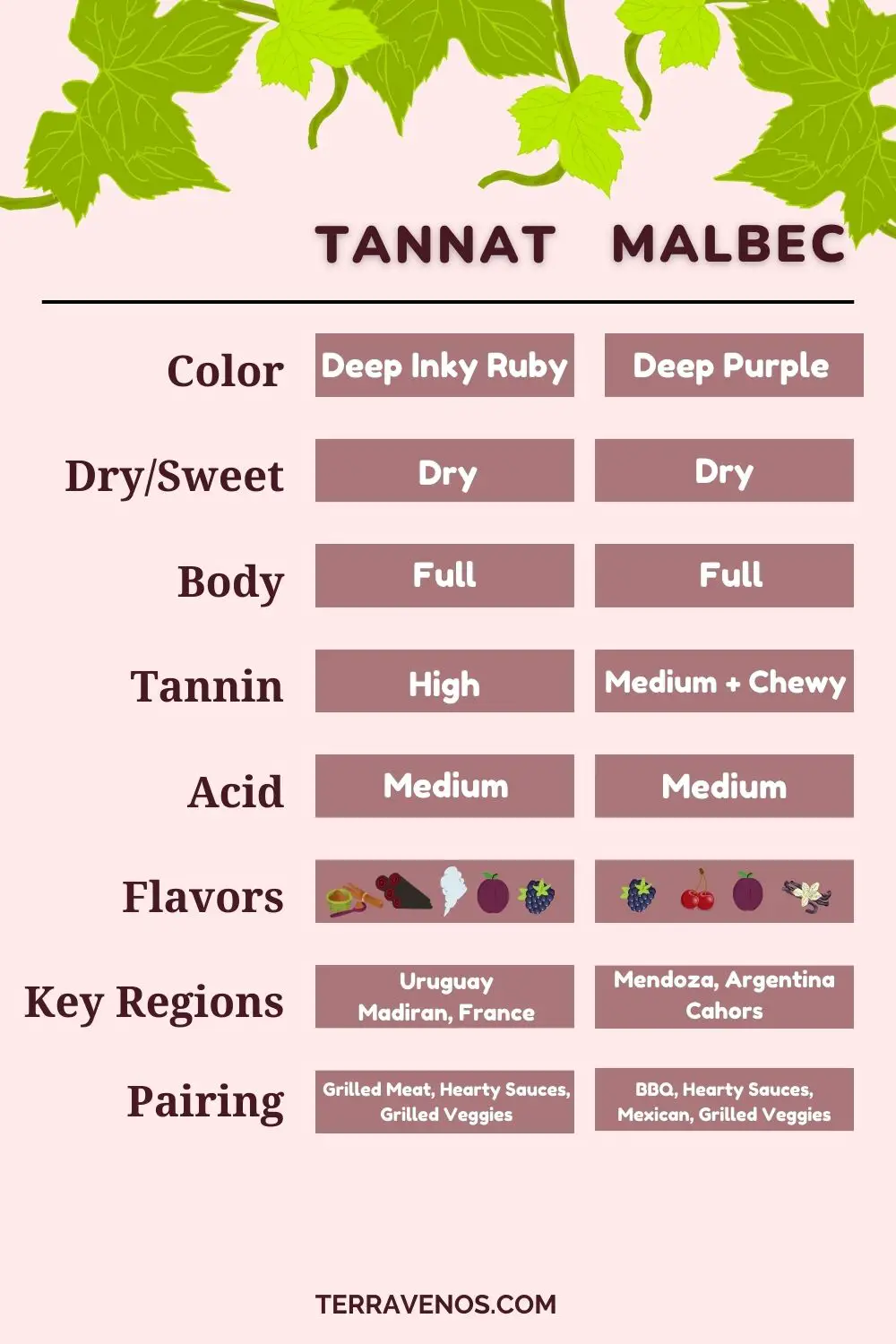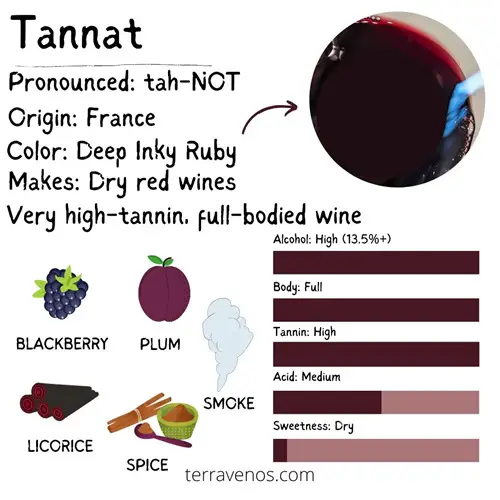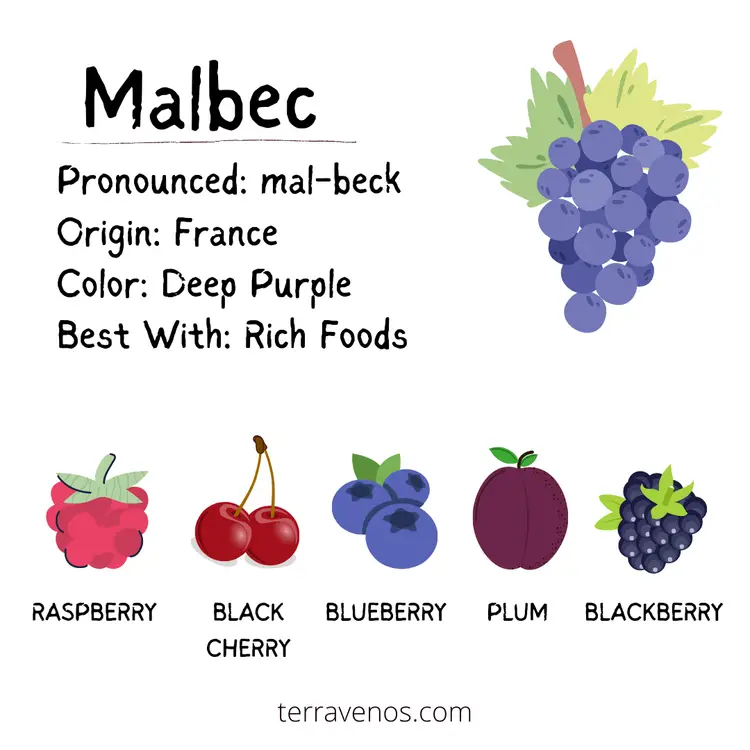
Comparing Tannat vs Malbec makes sense. These two wines are popular in South America.
Tannat showcases a bolder body and robust flavors of dark fruits and spice compared to Malbec. Malbec offers a medium to full body, rich flavor, and often a plush texture with blue fruit.
TL;DR: If you like the soft drinking nature of Malbec, you might not like Tannat.
Tannat Basics: A Powerful Red

Tannat, originating from France, is a powerful, tannic red wine grape that isn’t nearly as popular as some of the other big reds out there. Today, Tannat’s spiritual home is Uruguay, of all places, in a curious twist of wine fate. (Here’s a deep Tannat wines.)
You’ll find tiny pockets of Tannat grown outside of France and Uruguay from boutique producers. If you come across these wines, be sure to give them a try.
Wines from tannat are deeply colored, almost an inky-black, thanks to thick skins and small berries. Those skins leach out tannins into the wine, making for an astringent drinking experience. Tannat showcases black fruit, licorice, spice, and a smokey note.
Fun Wine Fact: The name “Tannat” derives from tannin, giving you a clue as to just how tannic this wine can be.
Malbec Basics: Argentine Elegance

Malbec, a true Argentine wine, offers an accessible red wine for all tables.
With origins in France, it found its true home in Argentina. Malbec showcases a distinct character with bold fruit flavors and a lush mouthfeel. Malbec’s medium to full body and flavors of ripe blackberries and plum pair well with grilled meats and hearty dishes. Its flavor profile includes dark fruits, cocoa, and sometimes a hint of vanilla, reflecting the hand of the winemaker.
Fun Wine Fact: Malbec gained significant popularity when it was introduced to Argentina in the 19th century. Today, Malbec has gained recognition beyond its Argentine origins, with vineyards in regions such as France, the United States, and Australia.
Wine Comparison: Tannat vs. Malbec
Here’s a quick side-by-side that covers the most common styles of Tannat and Malbec.
| Characteristics | Tannat | Malbec |
|---|---|---|
| Hue | Deep purple to inky black | Deep violet to inky black |
| Color | Red | Red to purple |
| Aromas | Dark fruit, chocolate, black tea | Blueberry, plum, black cherry, cocoa |
| Tannins | Very High | Medium – soft |
| Acid | Medium | Medium |
| Alcohol (%) | 13-15% | 13-15% |
| Body | Full | Medium to full |
| Intensity | Pronounced | Pronounced |
| Blending | Blended to soften | Blended to add structure |
| Key Growing Regions | Uruguay (Madiran, Tursan in France) | Argentina, France (Cahors) |
| Classic Pairings | Grilled meats, hearty stews | Grilled steak, barbecue |
| Price Range | $15-$40 | $10-$30 |
Tannat Wine Profile:
- Sweetness: Tannat is a dry red wine.
- Alcohol: Tannat wines generally have a moderate to high alcohol content, ranging from around 13% to 15% ABV.
- Body: Known for its bold body, Tannat provides a powerful and complex drinking experience.
- Tannins: Tannat has higher tannin levels compared to Malbec.
- Acid: Tannat has medium acid levels.
- Flavor and Aromas: Tannat will be medium plus to pronounced on the nose and palate with dark fruits, like blackberry and black plum, dark chocolate, licorice, and smoke.
Malbec Wine Profile:
- Sweetness: Malbec wines lean towards dryness, offering a range of dry to off-dry styles.
- Alcohol: Malbec wines typically have a moderate to high alcohol content, similar to Tannat, ranging from around 13% to 15% ABV.
- Body: Malbec is known for its medium to full body.
- Tannins: Malbec showcases moderate tannin levels, lower than Tannat.
- Acid: Malbec has medium acid levels, similar to Tannat.
- Flavor and Aromas: Malbec has medium to pronounced intensity on the nose and palate, with blackberry, blueberry, plum, cocoa, and sometimes a hint of vanilla.
Helpful Tip: Both Tannat and Malbec often have oak used during winemaking. Here’s what oak contributes to wine.
Are Tannat and Malbec Similar?
Both Tannat and Malbec are rich red wines that have dark fruit flavors. Both wines are often oaked, with mocha, coffee, and chocolate notes. They both have medium acid and similar alcohol levels.
What Is the Difference Between Tannat and Malbec?
Tannat tends to have a bolder body with much stronger tannins, compared to Malbec’s medium to full body and softer tannins. Tannat leans into black fruit, licorice, spice, and smoke and is more savory than Malbec’s blue and black fruit profile.
Tannat vs. Malbec: Food Pairings and Serving Temperature

Tannat Food Pairing: Tannat’s savory and dark fruit flavors make it a versatile companion for a variety of dishes, including grilled meats and stews. This is a wine you’ll want to pair with protein and fat.
Malbec Food Pairing: Malbec, with its plush mouthfeel and ripe fruit notes, pairs exceptionally well with grilled steaks, roasted vegetables, and barbecued ribs.
Personal Note: I love both Tannat and Malbec with grilled steaks and grilled vegetables.
Both Tannat and Malbec are best enjoyed at slightly below room temperature. Place them in a cool, dark place for a while before serving.
Which Is More Expensive, Tannat vs. Malbec?

When comparing the prices of Tannat and Malbec, it’s natural to wonder about their relative costs.
Tannat Cost
Entry-level Tannat wines are typically affordable, ranging from $15 to $20 per bottle.
If you are looking for premium Tannat, there are higher-priced Tannat wines available. These bottles, priced around $25 to $40 or higher, offer a more complex and nuanced drinking experience.
Helpful Tip: Tannat is slightly more expensive than Malbec because it’s more labor-intensive to make and not as popular, so lower overall production volume.
Malbec Cost
Similar to Tannat, entry-level Malbec wines also fall within accessible price ranges, usually ranging from $10 to $20 per bottle. These wines are known for their rich fruit flavors that forefront the plush mouthfeel, perfect for casual sipping and pairing.
On the premium side, Malbec will have more intense fruit flavors. You’ll immediately notice just how pronounced they can be. Premium Malbec wines sourced from renowned regions can have wine prices of $25 to $30 or more.
Fun Wine Fact: Premium Malbec from Argentina is often less expensive than premium wines from France thanks to favorable exchange rates and more affordable labor costs during production. Take advantage of this factoid to find outstanding bottles of Malbec wine!
Which Is Better Tannat or Malbec?
If you enjoy bold, robust red wine with more tannin, Tannat will be better for you. If you prefer a medium to full-bodied wine with a plush, silky mouthfeel, Malbec is the better choice. If you’re on a budget, Malbec is often less expensive for the quality level. If you have limited access to a range of wines, Malbec will be easier to find.

Final Thoughts – Tannat or Malbec?
Both Tannat and Malbec are distinctive experiences in your wine glass.
I’m a big fan of side-by-side tastings to tease out the different wine characteristics. A great way to get started with these two wines is to do a side-by-side comparison.
Grab 2 bottles of similarly priced Tannat and Malbec. Invite over a few friends and enjoy an evening of swirling and sipping.
Helpful Tip: These are both food wines. Make sure you have something to eat along with them.
Thirsty for More?
I’m a big believer in doing side-by-side tastings to boost your wine knowledge. Here’s how to host your own wine tasting for beginners.
Check out this post on Cabernet Sauvignon vs Merlot, another popular red wine, along with Cabernet Sauvignon vs Malbec, and Shiraz vs Merlot.
You should be able to find delicious wines at every price point. Check out this post on how to find great wines under $50.



